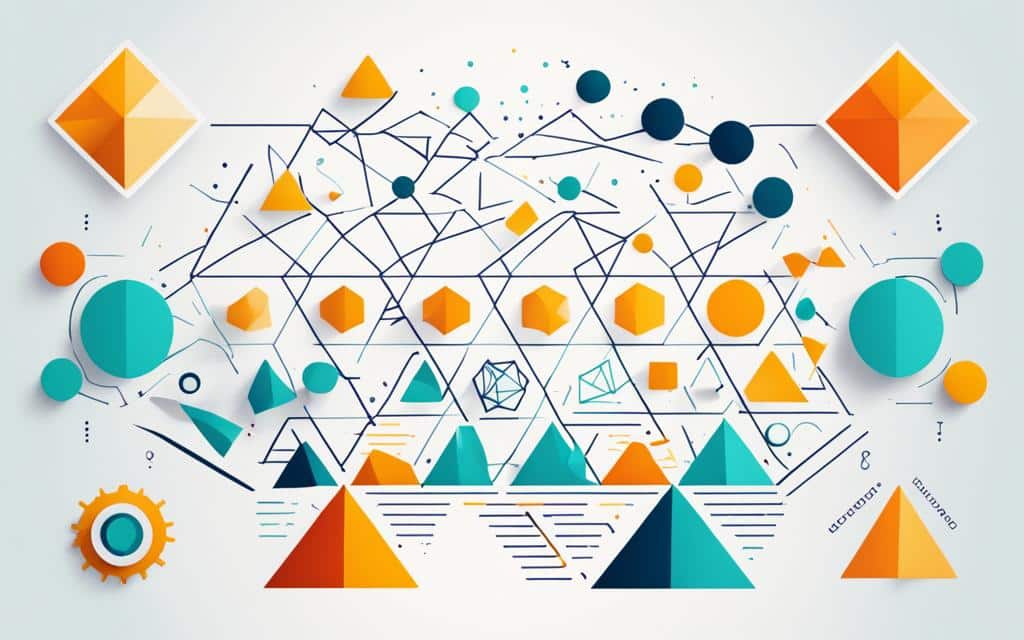Table of Contents
In the ever-changing landscape of the digital age, design systems have evolved significantly, revolutionizing the way we approach design work. Gone are the days when relying solely on style guides and patterns was enough. Today, design systems encompass a comprehensive and unified approach to design, incorporating distinct components, patterns, and new processes.
With the emergence of mobile technology, designers quickly realized the need for frameworks that could adapt to different screen sizes and provide more reliable user experiences. This led to the rise of modular design, where components could be rearranged and adjusted to fit any device.
But design systems aren’t just about adaptability. They also bring together branding and product identity, allowing companies to create a consistent and cohesive digital presence. By establishing brand guidelines and defining design principles within the system, designers and developers can work together seamlessly, ensuring that every touchpoint reflects the desired brand image.
Design systems serve as tools that align design and development, improve team communication and workflow, and increase overall efficiency. They provide a foundation for creating user-friendly, visually appealing, and technically sound digital experiences. As the digital age continues to evolve, design systems will play a crucial role in shaping the future of design.
The Role of Design Systems in Digital Products
Design systems play a crucial role in the development of digital products, ranging from websites to applications. They serve as a foundation for creating cohesive and consistent user experiences across different platforms and devices. Let’s explore the key aspects of design systems in the context of digital products.
Aligning Design and Development Processes
Design systems bridge the gap between design and development teams, ensuring a seamless flow of work. By providing a shared language, components, and guidelines, design systems enable designers and developers to collaborate effectively. This alignment leads to faster implementation, reduced errors, and improved efficiency throughout the project lifecycle.
Establishing Brand Consistency
Consistency is crucial for establishing a strong brand presence in the digital realm. Design systems enable designers to create brand-specific components, styles, and interactions that align with the brand’s visual identity. By maintaining a consistent look and feel, design systems contribute to reinforcing brand recognition and conveying a sense of professionalism.
Improving Communication and Collaboration
Design systems provide a common language for designers, developers, and other stakeholders involved in the product development process. This shared understanding promotes effective communication, streamlines decision-making, and reduces misunderstandings. With consistent design documentation and reference materials, teams can collaborate more efficiently, ensuring a smooth workflow.
Simplifying Team Workflow
A well-defined design system simplifies the workflow by providing reusable and modular components. These components can be easily implemented across different projects, saving time and effort. Designers can focus on higher-level tasks, such as solving complex design challenges, while relying on pre-established design patterns and guidelines provided by the design system.
Design systems go beyond traditional style guides and pattern libraries. They address the complexities of the digital landscape and focus on creating device-agnostic components. They provide a holistic approach to design, considering the entire user journey and the varying needs of different digital products.
Collaboration and Testing
Building a design system requires collaboration among various stakeholders, including designers, developers, and product managers. Collaboration ensures that the design system meets the needs and goals of the organization. Additionally, continuous testing and feedback loops help refine the design system, ensuring its effectiveness and adaptability to evolving requirements.
Now that we understand the role of design systems in digital products, let’s explore the principles that guide their development.
The Principles of Design Systems
Design systems are guided by several principles. They create a shared sense of purpose and values among teams working on digital products. Design systems also incorporate design principles to help teams make reliable decisions. They align with brand identity and marketing strategy, providing a set of meticulously maintained principles. Components and patterns are the building blocks of design systems, serving specific purposes and allowing for modular and flexible design. The incline of digital design systems has been crucial in shaping and updating the industry, providing a solid design foundation.
The Evolution of Product Design
Product design has evolved significantly over time, expanding its focus from industrial products to encompass complete experiences in both physical and digital realms. Today, the role of a product designer goes beyond creating visually appealing designs; it requires a deep understanding of customer insights, technology, collaboration, and problem-solving.
Product designers play a crucial role in the success of a company’s product by combining their innovative thinking with their visual and communication skills. They are not just individual contributors but also team players who collaborate with cross-functional teams to bring products to life.
To excel in product design, individuals need a structured learning plan and a strong interdisciplinary foundation. This combination equips them with the necessary skills to navigate the complexities of modern product design.
Key Skills for Product Designers
Product designers possess a diverse skill set that allows them to tackle various challenges throughout the design process. These skills include:
- Customer insights: Understanding user needs and preferences to create products that resonate with users.
- Technology understanding: Staying updated with the latest advancements in technology to incorporate them into product design.
- Collaboration: Working effectively with cross-functional teams, including engineers, marketers, and project managers.
- Problem-solving: Identifying and addressing design problems and finding innovative solutions.
- Innovation: Thinking creatively to come up with unique and impactful design concepts.
- Visual and communication skills: Translating ideas into visually appealing designs and effectively communicating design decisions.
“Product designers are the driving force behind the creation of successful products. Their ability to blend creativity, technical knowledge, and user-centric thinking is what sets them apart.”
A career in product design requires continuous learning and growth. Designers must stay updated with the latest design trends, technologies, and user expectations. Additionally, developing strong interpersonal skills and being adaptable to changing project requirements are crucial for success in this field.
As we continue to witness advancements in technology and user expectations, the field of product design will undoubtedly continue to evolve. By embracing this evolution, product designers can shape the future of design and contribute to creating impactful and user-centered products in the digital age.
The Future of Design Systems: Automation
Design systems have evolved into dynamic ecosystems that foster collaboration and consistency across digital platforms. However, the future of design systems lies in automation. Automated design systems offer efficiency, consistency, real-time updates, integration with development, and AI-powered design suggestions. They streamline the design and development workflow, reduce manual tasks, and enhance UX quality. However, challenges lie in acquiring skills needed to work effectively with automated tools and balancing automation with creativity. Embracing automation will be key for UI/UX professionals to stay ahead in the dynamic field of design systems.
The Challenges and Opportunities of Automated Design Systems
While automated design systems offer numerous benefits, they also bring challenges. Designers and developers must adapt to the new paradigm and acquire the necessary skills to work effectively with automated tools. Balancing automation and creativity is essential to ensure that automation enhances rather than stifles creativity. Striking the right balance between automated design decisions and human creativity can be challenging but necessary for innovative design solutions. Despite these challenges, automated design systems present opportunities to elevate the quality of digital experiences, reduce manual tasks, and foster creativity and innovation.
“The integration of automation in design systems has revolutionized the way designers and developers collaborate. However, it also poses challenges in striking the right balance between automation and creativity. It’s crucial for designers to understand the strengths and limitations of automated tools and leverage them to enhance their creative output.” – Mark Johnson, UI/UX Designer
Challenges of Automated Design Systems
Automated design systems introduce a shift in traditional design processes, requiring designers and developers to adapt and overcome several challenges:
- Acquiring new skills: Designers need to learn and master the tools and technologies behind automated design systems. This includes understanding AI-driven algorithms, machine learning, and data-driven design principles.
- Striking the right balance: Ensuring that automation doesn’t overshadow human creativity and intuition is crucial. Designers must find a balance between automated design decisions and their own artistic interpretation to create innovative and compelling designs.
- Managing complexity: Automated design systems can handle intricate design tasks, but they also introduce complexities in managing the automation process. Designers must learn to navigate and control automated tools effectively to achieve desired outcomes.
- Continuous learning: As technology evolves, designers need to keep up with the latest advancements in automated design systems and regularly update their skills to remain relevant in a fast-paced industry.
Opportunities of Automated Design Systems
Embracing automated design systems opens up exciting opportunities for designers and developers:
- Elevated quality of digital experiences: Automated design systems allow for consistency and precision in design, resulting in high-quality digital experiences that are visually appealing and user-friendly.
- Streamlined workflow: Automation reduces manual design tasks, freeing up time for designers to focus on more strategic and creative aspects of their work. This leads to increased productivity and efficient project delivery.
- Enhanced collaboration: Automated design systems facilitate seamless collaboration between design and development teams. With a unified system in place, teams can work together more effectively, aligning their efforts and reducing communication gaps.
- Fostering creativity and innovation: By automating repetitive and time-consuming design tasks, designers can dedicate more time and energy to exploring new ideas, pushing boundaries, and creating innovative design solutions.
Automated design systems present designers and developers with challenges that require adaptation and upskilling. However, by embracing these challenges and capitalizing on the opportunities they bring, professionals in the industry can harness the power of automation to elevate their design work, enhance user experiences, and drive innovation.
Conclusion
The future of design systems is poised for transformation through automation. With advancements in technology and the increasing complexity of interfaces, there is a rising demand for design solutions that are efficient, scalable, and error-free. Automated design systems provide an answer to these demands, offering enhanced efficiency, real-time updates, and seamless integration with development processes.
By embracing automation, UI/UX professionals can secure their position in the ever-evolving field of design systems and shape the future of digital experiences. Automation not only streamlines workflows but also opens up new creative possibilities. Designers can redirect their focus towards innovation and crafting meaningful user experiences that go beyond mere manual tasks.
As the industry moves towards automated design systems, it is crucial for professionals to acquire the necessary skills and embrace the changing paradigm. Striking the right balance between automated design decisions and human creativity will be paramount in driving forward innovative design solutions. Automated design systems offer a wealth of opportunities to elevate the quality of digital experiences, reduce manual efforts, and foster creativity and innovation.
FAQ
What are design systems?
Design systems are comprehensive frameworks that include distinct components, patterns, and new processes. They serve as a tool for aligning design and development, establishing brand consistency, improving communication and team workflow, and increasing efficiency.
How do design systems differ from style guides and pattern libraries?
While design systems cover similar fundamentals, they go beyond style guides and pattern libraries by addressing more complex tasks and focusing on creating electronic device-agnostic components.
What are the principles of design systems?
Design systems create a shared sense of purpose and values among teams, incorporate design principles to guide decision-making, align with brand identity and marketing strategy, and utilize components and patterns as building blocks for modular and flexible design.
How has product design evolved?
Product design has evolved from solely focusing on industrial products to designing complete experiences in physical and digital realms. It now involves customer insights, technology understanding, collaboration, and problem-solving.
What is the future of design systems?
The future of design systems lies in automation. Automated design systems offer efficiency, consistency, real-time updates, integration with development, and AI-powered design suggestions.
What are the challenges and opportunities of automated design systems?
Challenges include adapting to the new paradigm, acquiring the necessary skills to work with automated tools, and balancing automation with creativity. Opportunities include streamlining workflows, reducing manual tasks, and fostering creativity and innovation.
How can UI/UX professionals stay ahead in the field of design systems?
By embracing automation, UI/UX professionals can stay ahead in the dynamic field of design systems and shape the future of digital experiences. Automation streamlines workflows and opens up new creative possibilities.













